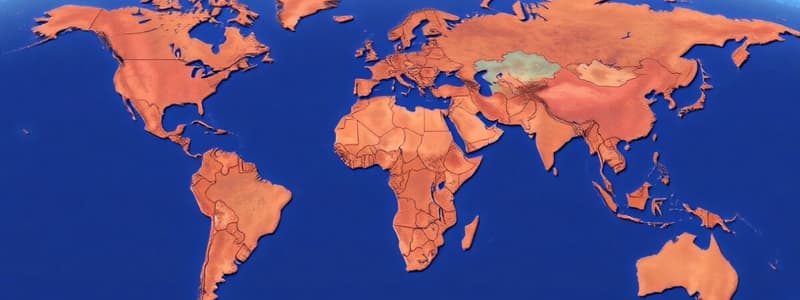Podcast
Questions and Answers
Which factor is least likely to influence migration patterns?
Which factor is least likely to influence migration patterns?
- Social networks
- Cultural festivals (correct)
- Economic opportunities
- Environmental conditions
What is a significant characteristic of subsistence agriculture?
What is a significant characteristic of subsistence agriculture?
- Crops are cultivated mainly for family consumption (correct)
- Production is primarily for sale in global markets
- Utilizes advanced agricultural technology significantly
- Requires extensive land and resources
Which of the following is NOT a major theme of AP Human Geography?
Which of the following is NOT a major theme of AP Human Geography?
- Political Organization of Space
- Cities and Urban Land Use
- Climate Change and Ecosystems (correct)
- Cultural Patterns and Processes
Which geographic tool is primarily used for analyzing spatial data?
Which geographic tool is primarily used for analyzing spatial data?
Which statement best reflects the concept of 'scale' in human geography?
Which statement best reflects the concept of 'scale' in human geography?
What is a consequence of urbanization that involves the displacement of original residents?
What is a consequence of urbanization that involves the displacement of original residents?
Which aspect of political geography explores the relationships between countries?
Which aspect of political geography explores the relationships between countries?
Which type of agriculture generally involves greater technical inputs and higher yields?
Which type of agriculture generally involves greater technical inputs and higher yields?
Flashcards are hidden until you start studying
Study Notes
Overview of AP Human Geography
- AP Human Geography is an introductory college-level course focusing on human interactions with the environment.
- It examines how human culture influences the landscape and vice versa.
Key Themes
-
Population and Migration
- Study of population distribution, density, demographics, and migration patterns.
- Factors influencing migration: economic, social, political, and environmental.
-
Cultural Patterns and Processes
- Exploration of cultural traits (language, religion, ethnicity).
- Influence of culture on spatial organization and landscape.
-
Political Organization of Space
- Analysis of political boundaries, sovereignty, and geopolitical relationships.
- Types of governance and territoriality.
-
Agricultural and Rural Land Use
- Examination of agricultural practices and rural land use patterns.
- Types of agriculture: subsistence vs. commercial, intensive vs. extensive.
-
Industrialization and Economic Development
- Study of industrial processes and economic systems.
- Link between industrial location and development patterns.
-
Cities and Urban Land Use
- Exploration of urbanization trends, city models, and land use planning.
- Issues related to urbanization: sprawl, gentrification, etc.
Major Concepts
- Place and Region: Understanding how regions are defined and the concept of place.
- Scale and Globalization: The impact of scale on human geography and the effects of globalization on cultures and economies.
- Spatial Interactions: How location affects interactions between people and places.
Geographic Tools and Techniques
- GIS (Geographic Information Systems): Used for mapping and analyzing spatial data.
- Remote Sensing: Techniques for gathering data from satellites and aerial imagery.
- Cartography: The art and science of map-making, including understanding different map types and scales.
Exam Structure
- Multiple Choice Questions: Assess knowledge and understanding of key concepts.
- Free-Response Questions: Requires critical thinking and the ability to apply knowledge in written form.
Study Tips
- Focus on understanding key terms and themes in human geography.
- Use maps and spatial data examples to reinforce concepts.
- Practice past exam questions to prepare for the exam format.
- Engage with real-world case studies to contextualize theoretical concepts.
AP Human Geography Overview
- Focuses on human interactions with the environment
- Examines how human culture influences the landscape and vice versa
Population and Migration
- Studies population distribution, density, demographics, and migration patterns
- Factors that influence migration: economic, social, political, and environmental
Cultural Patterns and Processes
- Explores cultural traits such as language, religion, and ethnicity
- Examines the influence of culture on spatial organization and landscape
Political Organization of Space
- Analyzes political boundaries, sovereignty, and geopolitical relationships
- Covers different types of governance and territoriality
Agricultural and Rural Land Use
- Examines agricultural practices and rural land use patterns
- Types of agriculture include subsistence vs. commercial, intensive vs. extensive
Industrialization and Economic Development
- Studies industrial processes and economic systems
- Analyzes the link between industrial location and development patterns
Cities and Urban Land Use
- Explores urbanization trends, city models, and land use planning
- Addresses urban issues such as sprawl, gentrification, etc.
Major Concepts
- Place and Region: Understanding how regions are defined and the concept of place
- Scale and Globalization: The impact of scale on human geography and the effects of globalization on cultures and economies
- Spatial Interactions: How location affects interactions between people and places
Geographic Tools and Techniques
- GIS (Geographic Information Systems): Used for mapping and analyzing spatial data
- Remote Sensing: Techniques for gathering data from satellites and aerial imagery
- Cartography: The art and science of map-making, including understanding different map types and scales
Exam Structure
- Multiple Choice Questions: Assess knowledge and understanding of key concepts
- Free-Response Questions: Requires critical thinking and the ability to apply knowledge in written form
Study Tips
- Focus on understanding key terms and themes in human geography
- Use maps and spatial data examples to reinforce concepts
- Practice past exam questions to prepare for the exam format
- Engage with real-world case studies to contextualize theoretical concepts
Studying That Suits You
Use AI to generate personalized quizzes and flashcards to suit your learning preferences.




